Visualization and Analysis of Mapping Knowledge Domains for Food Waste Studies
Abstract
1. Introduction
2. Materials and Methods
2.1. Data Source
2.2. Methods
3. Results
3.1. Yearly Quantitative Distribution of the Literature
3.2. Quantitative Analysis of Production Countries/Regions
3.3. Research Institutions Focused on Quantitative Analysis
3.4. Authors of Hot Literature
3.5. Quantitative Analysis of Major Source Journals and Subject
3.6. Keyword Co-Occurrence Analysis
- Cluster 1 (C1) includes “anaerobic-digestion”, “anaerobic co-digestion”, and “biochemical methane potential”, which represents the most common research field in FW. “Anaerobic digestion (AD)” refers to the rapid degradation of complex organic matter into biogas through anaerobic microorganisms’ metabolic activities under hypoxia conditions [19]. “Anaerobic co-digestion” refers to the process of co-digesting FW with other organic feeds (such as animal manure, crop straw, and activated sludge) to improve AD efficiency and reduce reaction residues [20].
- Cluster 2 (C2): The core keyword is “hydrogen production”, its total connection strength is 5166, and the number of co-occurrences is 913. Food waste is rich in carbohydrates and protein, with a balanced nutrient ratio. It is an ideal substrate for anaerobic hydrogen production [21]. Hydrogen production by anaerobic fermentation is a new type of hydrogen production method that uses anaerobic heterotrophic bacteria and organic matter as a substrate to produce hydrogen. Its mild reaction, high hydrogen production capacity, and strong applicability of raw materials have become a resource for kitchen waste [22].
- Cluster 3 (C3) is mainly related to the field of aerobic composting, and its keywords include” manure”, “pig manure”, and “compost”. The essence of aerobic composting is a dynamic process of various microorganisms working together under aerobic conditions to convert difficult-to-decompose organic matter into stable humus. FW usually contains a high concentration of easily degradable organic substances, such as sugar, starch, lipid, and protein, and is a high-quality composting material [23].
- Cluster 4 (C4): It can be seen that C4 mainly represents macrolevel management methods, including “model” and “life-cycle assessment”. “Life-cycle assessment” has been proven to play an important role in research on the environmental impact of food waste and sustainability [9]. Research on consumer behavior in the food supply chain has also begun to emerge. The level of social education and publicity management often determines the amount of food waste to a certain extent [24].
- Cluster 5 (C5) mainly focuses on the keyword “biomass”, followed by keywords such as “ethanol production”, “lactic acid”, “biodiesel”, and “phenolic compounds”. This clustering mainly reflects another direction in the field of food waste research is the biorefinery of other high value-added chemicals, including activated carbon adsorbent, antioxidants, bioactive, fuels, biomaterials, corrosion inhibitors, enzymes [6,25,26,27,28]. It can be seen that compared with other clusters, there is less research in this direction, which is mainly due to the high economic cost and low output efficiency.
4. Evolution Path Analysis
4.1. Reference Co-Citation
4.2. Research Front Identification
5. Conclusions
- FW research progress can be roughly divided into four stages: primary development stage (before 2007), consolidation and stability stage (2008–2014), and rapid development stage (2015 to present).
- FW research results are unevenly distributed worldwide, and mainly concentrated in Europe, America, and East Asian countries. There are few research results from Africa. China has become the country with the highest article productivity. In addition, research institutions in South Korea, the United States, and France are all leading in CPP, which shows that the average quality of their papers is high. The hot research area of FW has changed from European and American countries to East Asian countries.
- There are 8298 research articles in 8064 journals in a total of 176 WoS subject categories. Research in the FW field is mainly concentrated in the fields of environment, energy, biotechnology, and sustainability. All publications are concentrated in some journals, such as Bioresource Technology, Waste Management, and Journal of Cleaner Production.
- By systematically analyzing the distribution of the authors’ keywords, it can be concluded that the research in the FW field is mainly divided into five areas, namely “anaerobic digestion or biogas”, “biological hydrogen production”, and “aerobic composting”. “system management” and “generation of value-added products”. Combined with the research on the timeline of keywords, it can be seen that the processing technology of FW, the “anaerobic digestion” composting” and the refined control of “biological hydrogen production” has attracted wide attention from researchers from various countries before 2010. After this, in 2010, management methods aimed at “sustainable development” became the focus of research.
- In the future, research on food waste from the food production side may provide new possibilities for “anti-food waste”. The whole supply–demand chain management methods, including “supply chain tracking network” and “life cycle assessment“, would become research hotspots. Efficient and multitask biological value-added transformation technologies, systematic decision support models, and different management strategies for different groups may become the forefront of research. Meanwhile, the mechanism research is still not neglected by researchers, and the whole process control of food “production–classification–collection–disposal” by managers is still an essential guarantee for the large-scale promotion of food waste resources.
Author Contributions
Funding
Institutional Review Board Statement
Informed Consent Statement
Data Availability Statement
Conflicts of Interest
Appendix A
| Rank | Type of Literature | Frequency | Proportion (%) |
|---|---|---|---|
| 1 | Article | 6784 | 81.755 |
| 2 | Proceedings paper | 1050 | 12.654 |
| 3 | Review | 626 | 7.544 |
| 4 | Meeting abstract | 103 | 1.241 |
| 5 | Editorial material | 56 | 0.675 |
| 6 | Early access | 37 | 0.446 |
| 7 | News item | 35 | 0.422 |
| 8 | Book review | 16 | 0.193 |
| 9 | Correction | 15 | 0.181 |
| 10 | Letter | 8 | 0.096 |
| 11 | Book chapter | 6 | 0.072 |
| 12 | Data paper | 3 | 0.036 |
| Total | 8298 |
| Rank | Author | Country | Organization | TP ① | P ② | H ③ | CPP ④ | TLS ⑤ |
|---|---|---|---|---|---|---|---|---|
| 1 | Wang Qunhui | China | University of Science and Technology Beijing | 51 | 0.75 | 28 | 15.18 | 153 |
| 2 | Kim Donghoon | South Korea | Inha University | 38 | 0.56 | 28 | 27.79 | 111 |
| 3 | Lin, Carol Sze Ki | China | City University of Hong Kong | 38 | 0.56 | 33 | 47.89 | 70 |
| 4 | Wong Jonathan C.W. | China | Hong Kong Baptist University | 38 | 0.56 | 25 | 35.84 | 61 |
| 5 | Li Yuyou | Japan | Tohoku University | 37 | 0.55 | 26 | 34.00 | 91 |
| 6 | Mohan S. Venkata | India | Indian Institute of Chemical Technology | 33 | 0.49 | 10 | 33.00 | 10 |
| 7 | Ok Yong Sik | South Korea | Kangwon National University | 32 | 0.47 | 72 | 36.44 | 150 |
| 8 | Tsang Daniel C.W. | China | Hong Kong Polytechnic University | 31 | 0.46 | 4 | 38.35 | 149 |
| 9 | Zhang Ruihong | China | Harbin Institute of Technology | 29 | 0.43 | 39 | 62.55 | 89 |
| 10 | Ma Hongzhi | China | University of Science and Technology Beijing | 28 | 0.41 | 23 | 11.89 | 78 |
| Rank | Journal Title | Country | Ps ① | P ② | H ③ | TC ④ | CPP ⑤ | CI ⑥ |
|---|---|---|---|---|---|---|---|---|
| 1 | Bioresource Technology | Netherlands | 797 | 9.883 | 77 | 27,876 | 34.79 | SCIE |
| 2 | Waste Management | United Kingdom | 500 | 6.2 | 65 | 15,971 | 31.94 | SCIE |
| 3 | Journal of Cleaner Production | Netherlands | 294 | 3.646 | 40 | 7401 | 25.17 | SCIE |
| 4 | International Journal of Hydrogen Energy | United Kingdom | 238 | 2.951 | 48 | 10,181 | 42.78 | SCIE |
| 5 | Sustainability | Switzerland | 149 | 1.848 | 18 | 1395 | 9.36 | SCIE/SSCI |
| 6 | Journal of Environmental Management | United States | 137 | 1.699 | 29 | 3319 | 24.23 | SCIE |
| 7 | Resources Conservation and Recycling | Netherlands | 131 | 1.625 | 33 | 3593 | 27.43 | SCIE |
| 8 | Waste Management Research | United Kingdom | 112 | 1.389 | 24 | 1905 | 17.01 | SCIE |
| 9 | Science of the Total Environment | Netherlands | 99 | 1.228 | 20 | 2881 | 29.1 | SCIE |
| 10 | Water Science and Technology | United Kingdom | 92 | 1.141 | 23 | 1648 | 17.91 | SCIE |
| Rank | Discipline | Ps ① | H ② | CPP ③ |
|---|---|---|---|---|
| 1 | Environmental sciences | 2725 | 96 | 21.14 |
| 2 | Energy fuels | 1924 | 103 | 20.44 |
| 3 | Engineering environmental | 1733 | 89 | 23.53 |
| 4 | Biotechnology applied microbiology | 1438 | 87 | 29.37 |
| 5 | Green sustainable science technology | 898 | 65 | 22.65 |
| 6 | Agricultural engineering | 895 | 79 | 33.1 |
| 7 | Engineering chemical | 701 | 53 | 19.7 |
| 8 | Food science technology | 568 | 51 | 20.41 |
| 9 | Chemistry physical | 302 | 53 | 39.69 |
| 10 | Chemistry multidisciplinary | 281 | 33 | 16.56 |
References
- Hafid, H.S.; Rahman, N.A.A.; Shah, U.K.M.; Baharuddin, A.S.; Ariff, A.B. Feasibility of using kitchen waste as future substrate for bioethanol production: A review. Renew. Sustain. Energy Rev. 2017, 74, 671–686. [Google Scholar] [CrossRef]
- FAO. The State of Food Security and Nutrition in the World 2019 Building Resilience for Peace and Food Securitybrif. In The State of Food Security and Nutrition in the World—FAO; Food and Agriculture Organization of the United Nations: Rome, Italy, 2019. [Google Scholar]
- Ma, Y.; Liu, Y. Turning food waste to energy and resources towards a great environmental and economic sustainability: An innovative integrated biological approach. Biotechnol. Adv. 2019, 37, 107414. [Google Scholar] [CrossRef] [PubMed]
- Slorach, P.C.; Jeswani, H.K.; Cuellar-Franca, R.; Azapagic, A. Environmental sustainability of anaerobic digestion of household food waste. J. Environ. Manag. 2019, 236, 798–814. [Google Scholar] [CrossRef] [PubMed]
- Eriksson, M.; Strid, I.; Hansson, P.-A. Carbon footprInt. of food waste management options in the waste hierarchy—A Swedish case study. J. Clean. Prod. 2015, 93, 115–125. [Google Scholar] [CrossRef]
- Xiong, X.; Yu, I.K.M.; Tsang, D.C.W.; Bolan, N.S.; Sik Ok, Y.; Igalavithana, A.D.; Kirkham, M.B.; Kim, K.-H.; Vikrant, K. Value-added chemicals from food supply chain wastes: State-of-the-art review and future prospects. Chem. Eng. J. 2019, 375. [Google Scholar] [CrossRef]
- Corrado, S.; Caldeira, C.; Eriksson, M.; Hanssen, O.J.; Hauser, H.E.; van Holsteijn, F.; Liu, G.; Ostergren, K.; Parry, A.; Secondi, L.; et al. Food waste accounting methodologies: Challenges, opportunities, and further advancements. Glob. Food Sec. 2019, 20, 93–100. [Google Scholar] [CrossRef]
- Elkhalifa, S.; Al-Ansari, T.; Mackey, H.R.; McKay, G. Food waste to biochars through pyrolysis: A review. Resour. Conserv. Recycl. 2019, 144, 310–320. [Google Scholar] [CrossRef]
- Mayer, F.; Bhandari, R.; Gath, S. Critical review on life cycle assessment of conventional and innovative waste-to-energy technologies. Sci. Total Environ. 2019, 672, 708–721. [Google Scholar] [CrossRef]
- Chen, H.; Jiang, W.; Yang, Y.; Yang, Y.; Man, X. State of the art on food waste research: A bibliometrics study from 1997 to 2014. J. Clean. Prod. 2017, 140, 840–846. [Google Scholar] [CrossRef]
- Gorzen-Mitka, I.; Bilska, B.; Tomaszewska, M.; Kolozyn-Krajewska, D. Mapping the Structure of Food Waste Management Research: A Co-Keyword Analysis. Int. J. Environ. Res. Public Health 2020, 17, 4798. [Google Scholar] [CrossRef]
- Zhang, M.; Gao, M.; Yue, S.; Zheng, T.; Gao, Z.; Ma, X.; Wang, Q. Global trends and future prospects of food waste research: A bibliometric analysis. Environ. Sci Pollut Res. Int. 2018, 25, 24600–24610. [Google Scholar] [CrossRef] [PubMed]
- El Bilali, H.; Ben Hassen, T. Food Waste in the Countries of the Gulf Cooperation Council: A Systematic Review. Foods 2020, 9, 463. [Google Scholar] [CrossRef] [PubMed]
- van Eck, N.J.; Waltman, L. Software survey: VOSviewer, a computer program for bibliometric mapping. Scientometrics 2010, 84, 523–538. [Google Scholar] [CrossRef] [PubMed]
- Van Eck, N.J.; Waltman, L. VOS: A new method for visualizing similarities between objects. In Advances in Data Analysis; Decker, R., Lenz, H.J., Eds.; Springer: Berlin/Heidelberg, Germany, 2007; pp. 299–306. [Google Scholar]
- Chen, C. CiteSpace II: Detecting and Visualizing Emerging Trends and Transient Patterns in Scientific Literature. J. Am. Soc. Inf. Sci. Technol. 2006, 27, 359–377. [Google Scholar] [CrossRef]
- Hong, R.; Xiang, C.L.; Liu, H.; Glowacz, A.; Pan, W. Visualizing the Knowledge Structure and Research Evolution of Infrared Detection Technology Studies. Information 2019, 10, 227. [Google Scholar] [CrossRef]
- Schwartz, M.B.; Henderson, K.E.; Read, M.; Danna, N.; Ickovics, J.R. New school meal regulations increase fruit consumption and do not increase total plate waste. Child. Obes. 2015, 11, 242–247. [Google Scholar] [CrossRef] [PubMed]
- Panepinto, D.; Riggio, V.A.; Campo, G.; Cerutti, A.; Comoglio, C.; Zanetti, M.C. Analysis of two treatment technologies for coffee roasting matrixes: Combustion and anaerobic digestion. Clean Technol. Environ. Policy 2019, 21, 685–694. [Google Scholar] [CrossRef]
- Xie, S.; Hai, F.I.; Zhan, X.; Guo, W.; Ngo, H.H.; Price, W.E.; Nghiem, L.D. Anaerobic co-digestion: A critical review of mathematical modelling for performance optimization. Bioresour. Technol. 2016, 222, 498–512. [Google Scholar] [CrossRef] [PubMed]
- Yun, Y.M.; Lee, M.K.; Im, S.W.; Marone, A.; Trably, E.; Shin, S.R.; Kim, M.G.; Cho, S.K.; Kim, D.H. Biohydrogen production from food waste: Current status, limitations, and future perspectives. Bioresour. Technol. 2018, 248, 79–87. [Google Scholar] [CrossRef]
- Cavinato, C.; Giuliano, A.; Bolzonella, D.; Pavan, P.; Cecchi, F. Bio-hythane production from food waste by dark fermentation coupled with anaerobic digestion process: A long-term pilot scale experience. Int. J. Hydrogen Energy 2012, 37, 11549–11555. [Google Scholar] [CrossRef]
- Yang, F.; Li, Y.; Han, Y.; Qian, W.; Li, G.; Luo, W. Performance of mature compost to control gaseous emissions in kitchen waste composting. Sci. Total Environ. 2019, 657, 262–269. [Google Scholar] [CrossRef] [PubMed]
- Reynolds, C.; Goucher, L.; Quested, T.; Bromley, S.; Gillick, S.; Wells, V.K.; Evans, D.; Koh, L.; Carlsson Kanyama, A.; Katzeff, C.; et al. Review: Consumption-stage food waste reduction interventions—What works and how to design better interventions. Food Policy 2019, 83, 7–27. [Google Scholar] [CrossRef]
- Zhao, J.; Jing, Y.; Zhang, J.; Sun, Y.; Wang, Y.; Wang, H.; Bi, X. Aged refuse enhances anaerobic fermentation of food waste to produce short-chain fatty acids. Bioresour. Technol. 2019, 289, 121547. [Google Scholar] [CrossRef] [PubMed]
- Cao, L.; Yu, I.K.M.; Tsang, D.C.W.; Zhang, S.; Ok, Y.S.; Kwon, E.E.; Song, H.; Poon, C.S. Phosphoric acid-activated wood biochar for catalytic conversion of starch-rich food waste into glucose and 5-hydroxymethylfurfural. Bioresource Technology 2018, 267, 242–248. [Google Scholar] [CrossRef] [PubMed]
- Tsang, Y.F.; Kumar, V.; Samadar, P.; Yang, Y.; Lee, J.; Ok, Y.S.; Song, H.; Kim, K.H.; Kwon, E.E.; Jeon, Y.J. Production of bioplastic through food waste valorization. Environ. Int. 2019, 127, 625–644. [Google Scholar] [CrossRef] [PubMed]
- Sindhu, R.; Gnansounou, E.; Rebello, S.; Binod, P.; Varjani, S.; Thakur, I.S.; Nair, R.B.; Pandey, A. Conversion of food and kitchen waste to value-added products. J. Environ. Manag. 2019, 241, 619–630. [Google Scholar] [CrossRef] [PubMed]
- Small, H. Co-citation in the scientific literature: A new measure of the relationship between two documents. J. Am. Soc. Inf. Sci. 1973, 24, 265–269. [Google Scholar] [CrossRef]
- Chen, C.M. Searching for intellectual turning points: Progressive knowledge domain visualization. Proc. Natl. Acad. Sci. USA 2004, 101, 5303–5310. [Google Scholar] [CrossRef]
- Saratale, G.D. Outlook of biohydrogen production from lignocellulosic feedstock using dark fermentation ?a review. J. Sci. Lnd. Res. 2008, 67. [Google Scholar]
- Wang, H.; Xu, J.; Sheng, L. Study on the comprehensive utilization of city kitchen waste as a resource in China. Energy 2019, 173, 263–277. [Google Scholar] [CrossRef]
- Deepanraj, B.; Sivasubramanian, V.; Jayaraj, S. Effect of substrate pretreatment on biogas production through anaerobic digestion of food waste. Int. J. Hydrogen Energy 2017, 42, 26522–26528. [Google Scholar] [CrossRef]
- Kim, D.-H.; Jang, S.; Yun, Y.-M.; Lee, M.-K.; Moon, C.; Kang, W.-S.; Kwak, S.-S.; Kim, M.-S. Effect of acid-pretreatment on hydrogen fermentation of food waste: Microbial community analysis by next generation sequencing. Int. J. Hydrogen Energy 2014, 39, 16302–16309. [Google Scholar] [CrossRef]
- Liu, H.; Chen, H.; Hong, R.; Liu, H.; You, W. Mapping knowledge structure and research trends of emergency evacuation studies. Safety Science 2020, 121, 348–361. [Google Scholar] [CrossRef]
- Kim, S. Feasibility of biohydrogen production by anaerobic co-digestion of food waste and sewage sludge. Int. J. Hydrogen Energy 2004, 29, 1607–1616. [Google Scholar] [CrossRef]
- Kim, D.-H.; Kim, S.-H.; Kim, H.-W.; Kim, M.-S.; Shin, H.-S. Sewage sludge addition to food waste synergistically enhances hydrogen fermentation performance. Bioresourc. Technol. 2011, 102, 8501–8506. [Google Scholar] [CrossRef] [PubMed]
- Kim, S.-H.; Han, S.-K.; Shin, H.-S. Optimization of continuous hydrogen fermentation of food waste as a function of solids retention time independent of hydraulic retention time. Process Biochem. 2008, 43, 213–218. [Google Scholar] [CrossRef]
- Du, C.; Abdullah, J.J.; Greetham, D.; Fu, D.; Yu, M.; Ren, L.; Li, S.; Lu, D. Valorization of food waste into biofertiliser and its field application. J. Clean. Prod. 2018, 187, 273–284. [Google Scholar] [CrossRef]
- Kim, D.-H.; Wu, J.; Jeong, K.-W.; Kim, M.-S.; Shin, H.-S. Natural inducement of hydrogen from food waste by temperature control. Int. J. Hydrogen Energy 2011, 36, 10666–10673. [Google Scholar] [CrossRef]
- Kim, D.-H.; Kim, S.-H.; Jung, K.-W.; Kim, M.-S.; Shin, H.-S. Effect of initial pH independent of operational pH on hydrogen fermentation of food waste. Bioresourc. Technol. 2011, 102, 8646–8652. [Google Scholar] [CrossRef]
- The World Bank. Total Greenhouse Gas Emissions in kt of CO2 Equivalent. Available online: https://data.worldbank.org/indicator/EN.ATM.GHGT.KT.CE (accessed on 2 May 2021).
- Wansink, B.; van Ittersum, K. Portion Size Me: Plate-Size Induced Consumption Norms and Win-Win Solutions for Reducing Food Intake and Waste. J. Exp. Psychol. -Appl. 2013, 19, 320–332. [Google Scholar] [CrossRef] [PubMed]
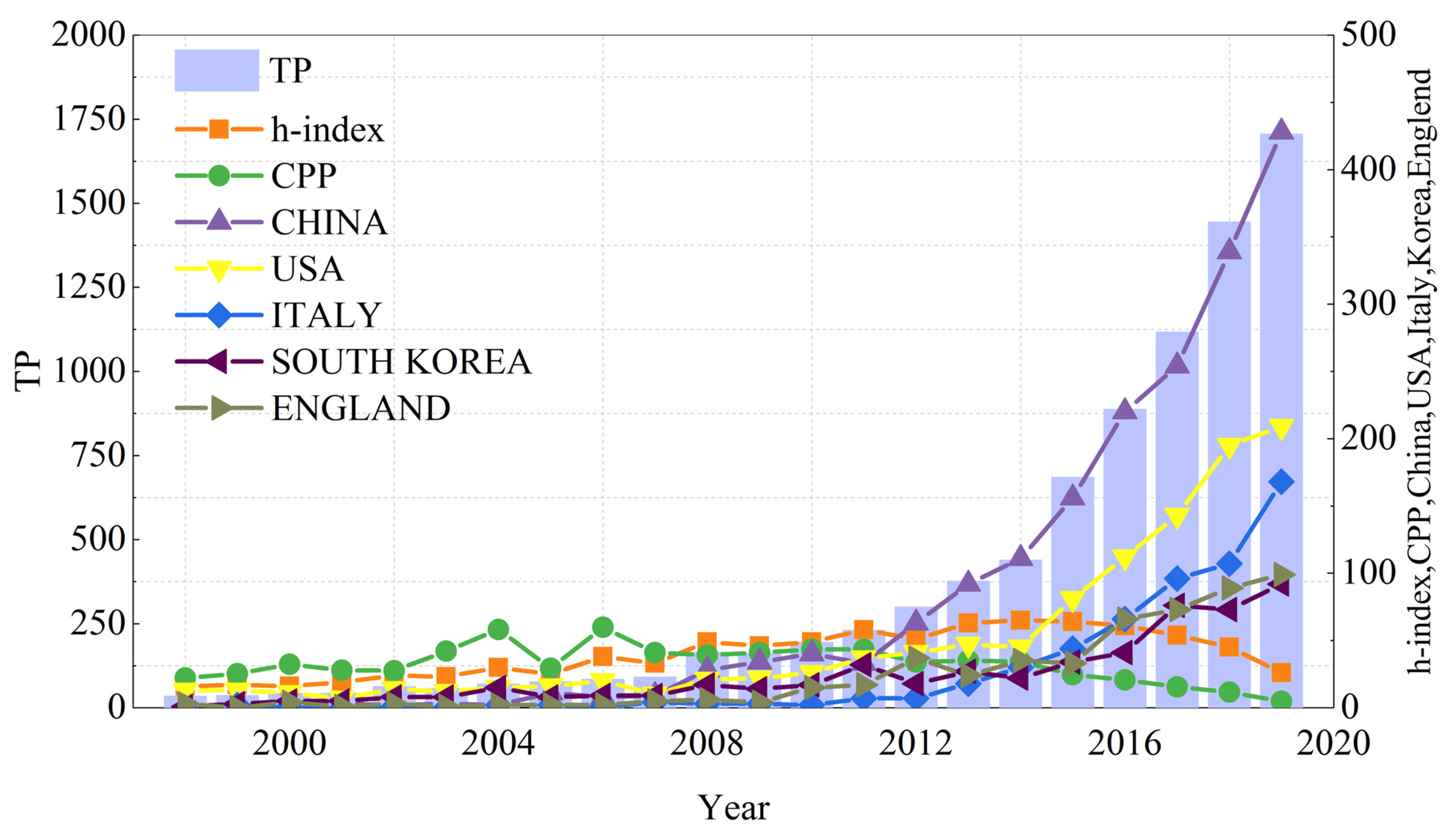
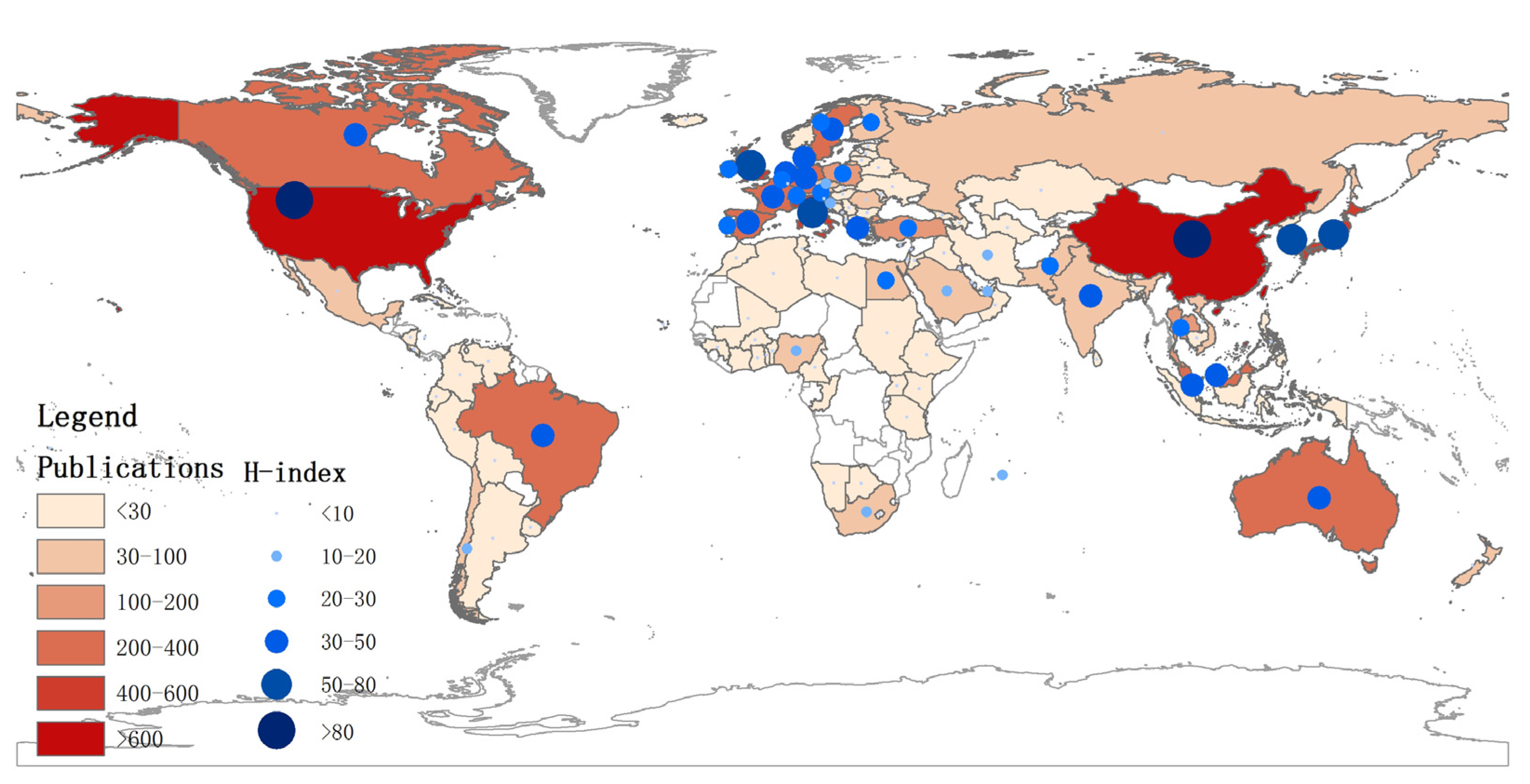
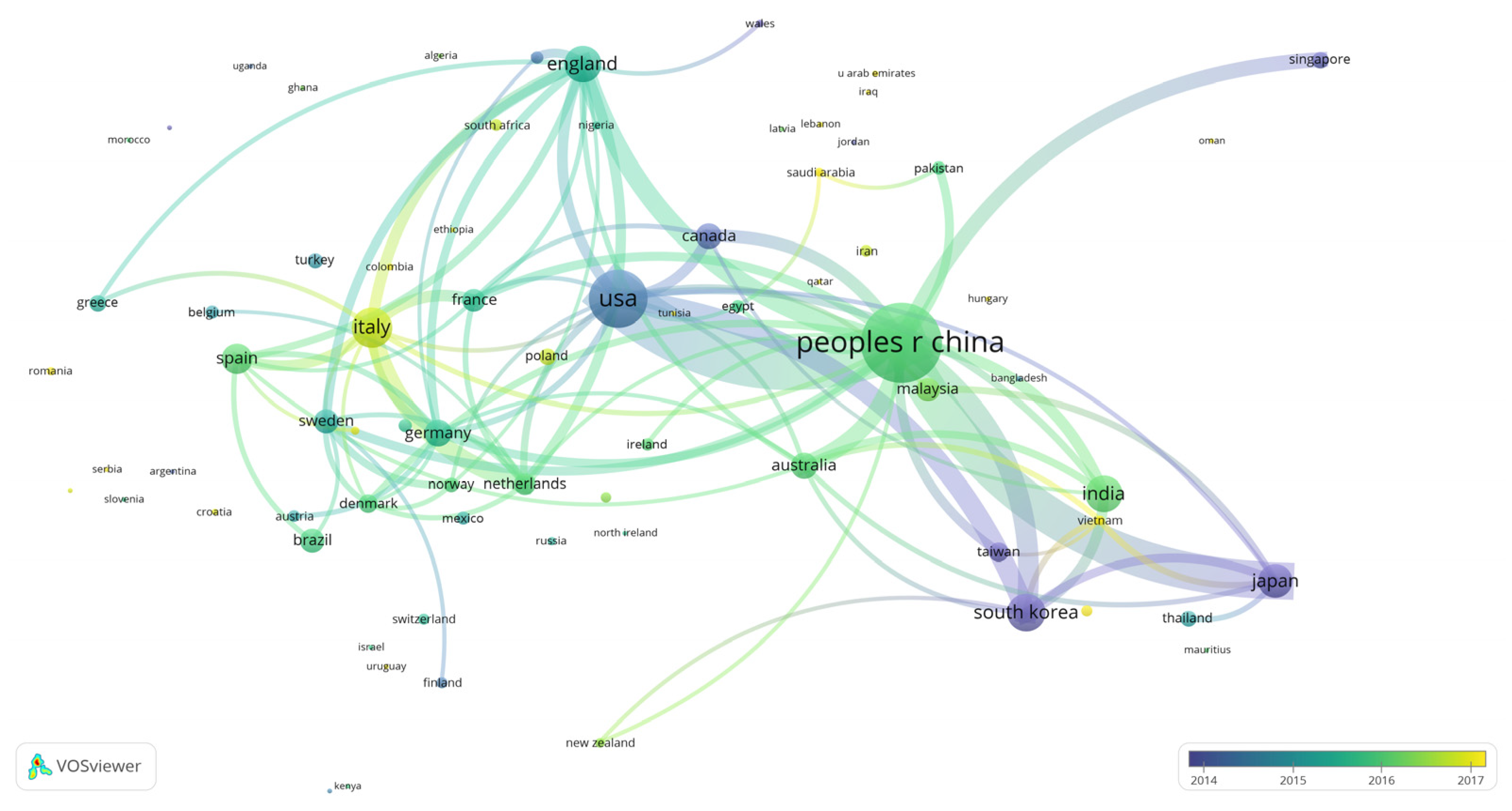


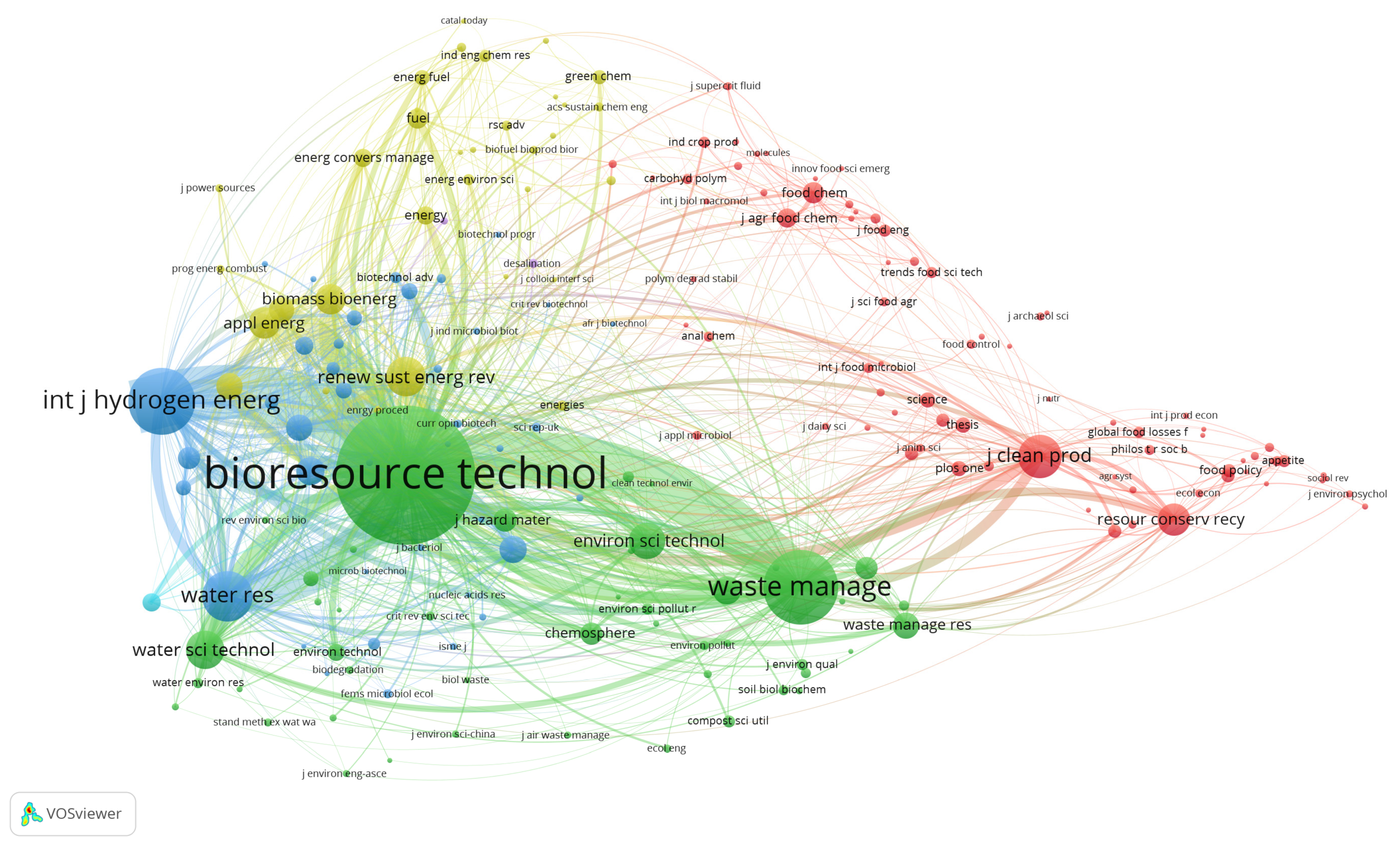
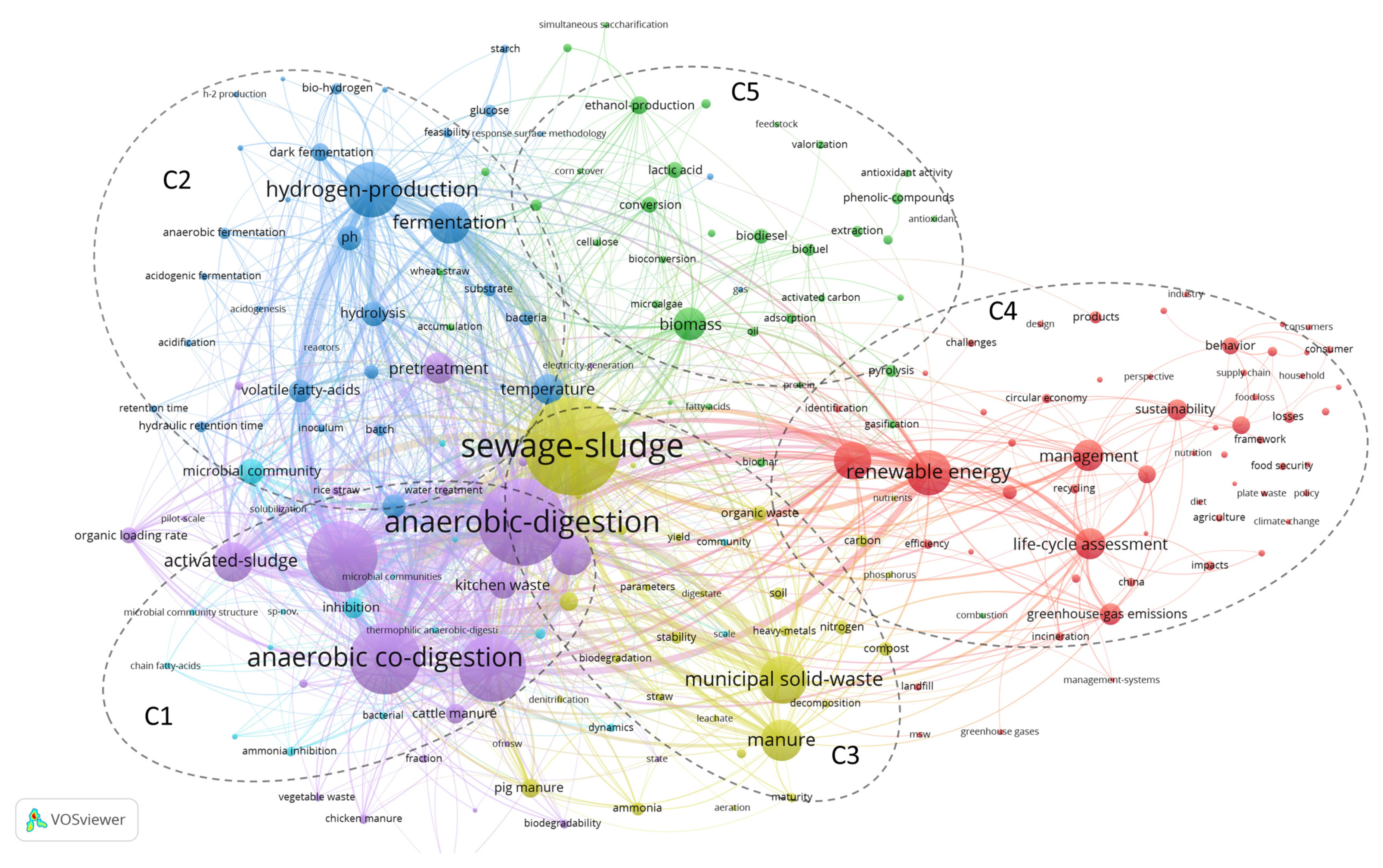
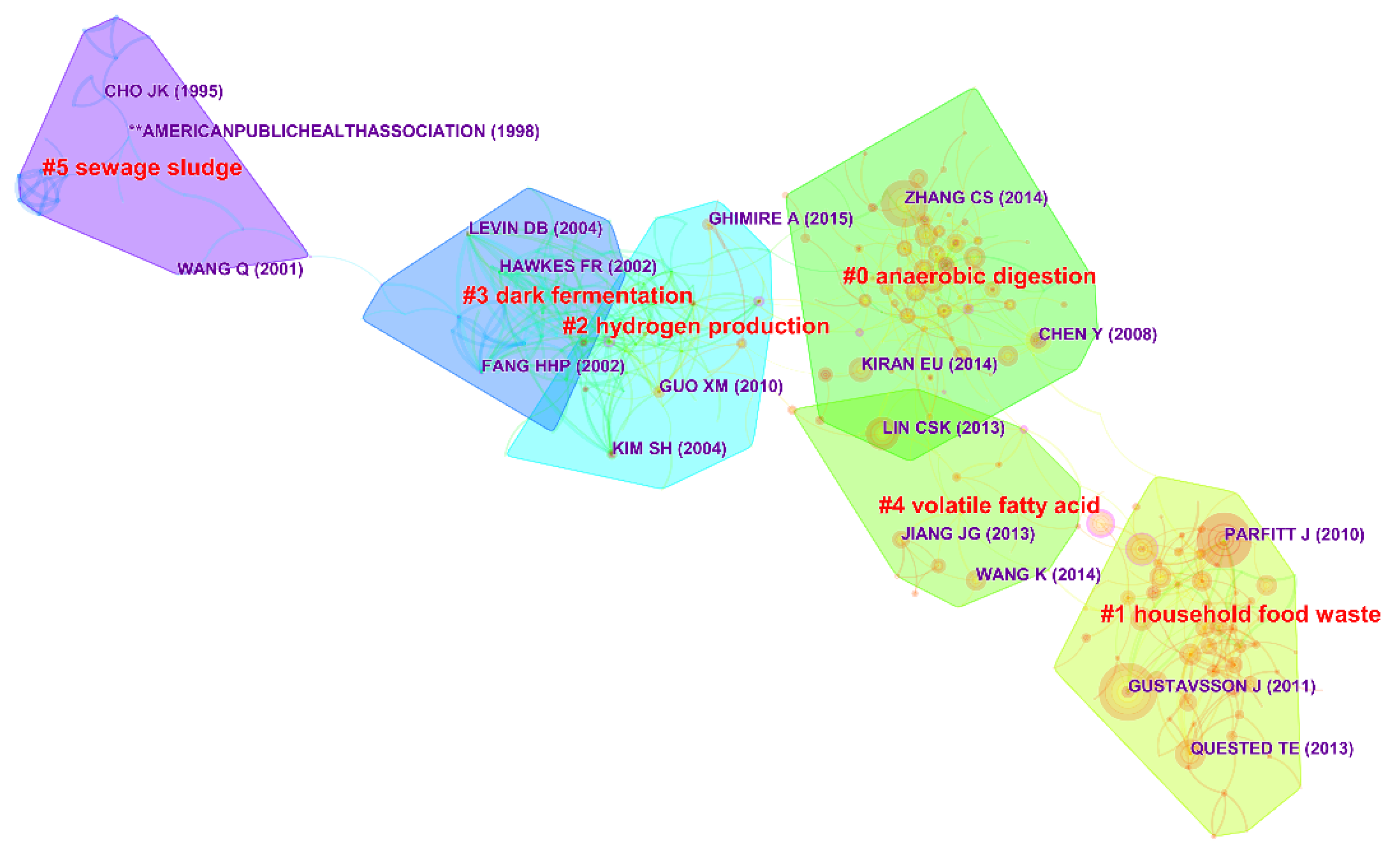
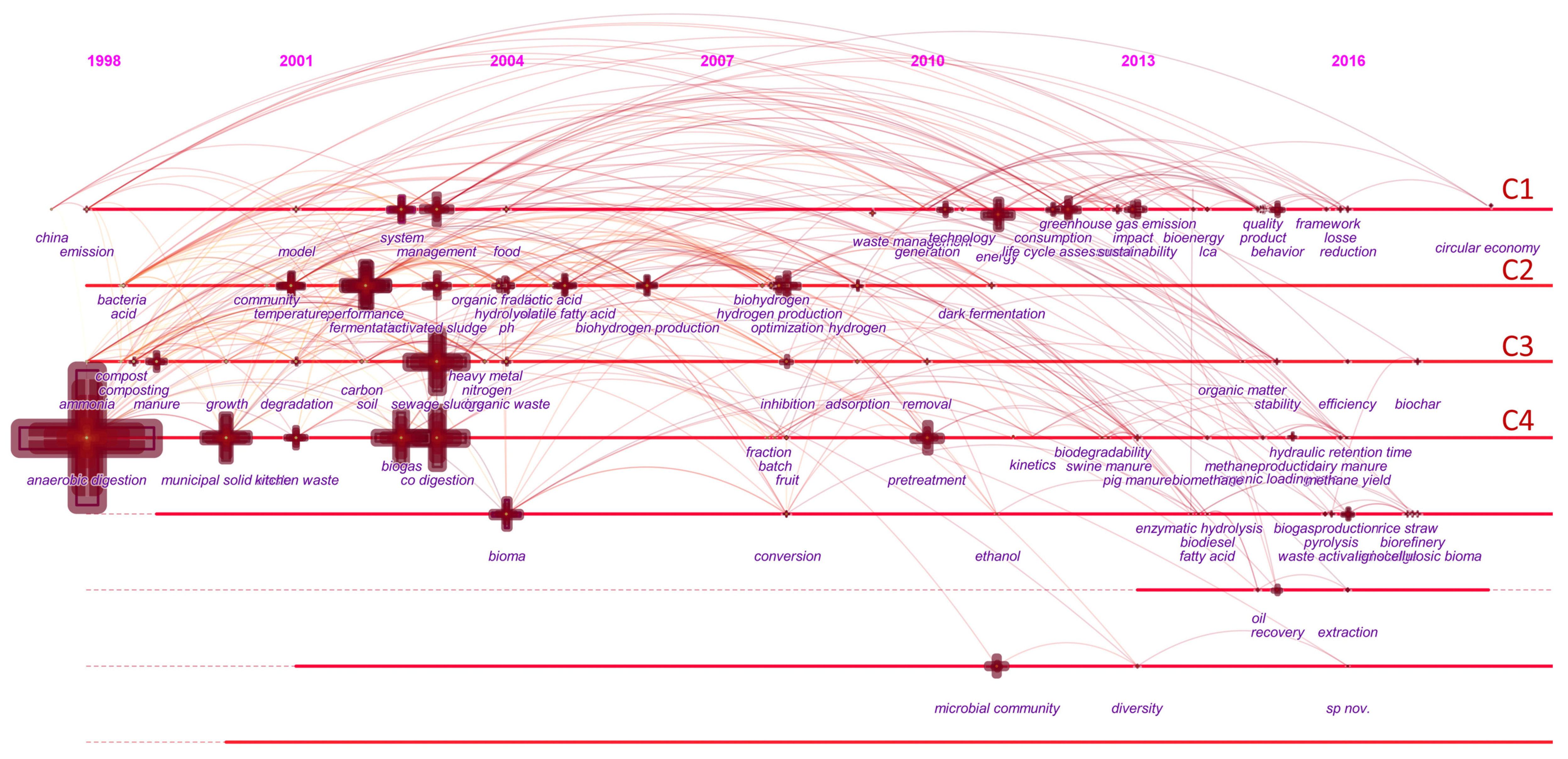
| Rank | Organization | Country | Ps ① | P ② | H ③ | CPP ④ |
|---|---|---|---|---|---|---|
| 1 | Chinese Academy of sciences | China | 174 | 2.158 | 30 | 19.17 |
| 2 | Tsinghua University | China | 162 | 2.009 | 35 | 27.9 |
| 3 | Tongji University | China | 121 | 1.500 | 32 | 25.35 |
| 4 | Council of Scientific Industrial Research | India | 102 | 1.265 | 28 | 20.11 |
| 5 | China Agricultural University | China | 93 | 1.153 | 27 | 24.08 |
| 6 | INRAE | France | 93 | 1.153 | 31 | 34.14 |
| 7 | University of California System | USA | 90 | 1.116 | 27 | 35.16 |
| 8 | KAIST | Korea | 81 | 1.004 | 30 | 41.42 |
| 9 | University of Science Technology Beijing | China | 79 | 0.980 | 20 | 17.67 |
| 10 | Indian Institute of Technology System | India | 77 | 0.955 | 21 | 23.86 |
Publisher’s Note: MDPI stays neutral with regard to jurisdictional claims in published maps and institutional affiliations. |
© 2021 by the authors. Licensee MDPI, Basel, Switzerland. This article is an open access article distributed under the terms and conditions of the Creative Commons Attribution (CC BY) license (https://creativecommons.org/licenses/by/4.0/).
Share and Cite
Ouyang, Y.; Cai, Y.; Guo, H. Visualization and Analysis of Mapping Knowledge Domains for Food Waste Studies. Int. J. Environ. Res. Public Health 2021, 18, 5143. https://doi.org/10.3390/ijerph18105143
Ouyang Y, Cai Y, Guo H. Visualization and Analysis of Mapping Knowledge Domains for Food Waste Studies. International Journal of Environmental Research and Public Health. 2021; 18(10):5143. https://doi.org/10.3390/ijerph18105143
Chicago/Turabian StyleOuyang, Yiran, Yanpeng Cai, and Hongjiang Guo. 2021. "Visualization and Analysis of Mapping Knowledge Domains for Food Waste Studies" International Journal of Environmental Research and Public Health 18, no. 10: 5143. https://doi.org/10.3390/ijerph18105143
APA StyleOuyang, Y., Cai, Y., & Guo, H. (2021). Visualization and Analysis of Mapping Knowledge Domains for Food Waste Studies. International Journal of Environmental Research and Public Health, 18(10), 5143. https://doi.org/10.3390/ijerph18105143







